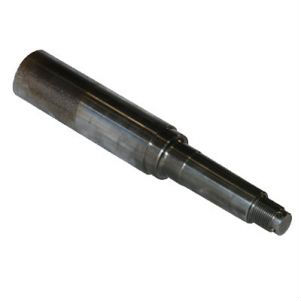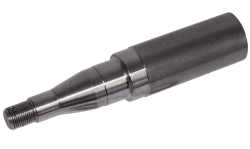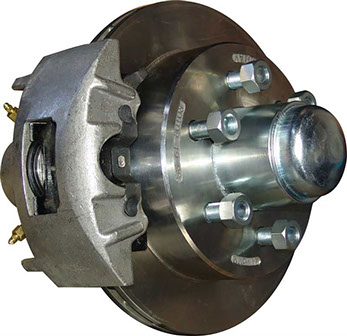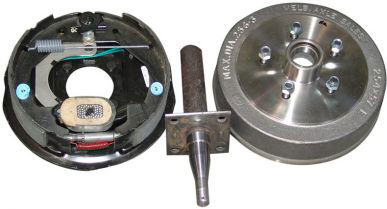Hubs and Spindles
Hubs and spindles come in a huge range of sizes, types and styles ranging from simple straight shaft axles suitable for very lightweight trailers to large taper roller bearing setups for heavy duty operations.
Just looking through a hub and spindle catalog and you will see there is quite a selection on offer and it pays to do your homework especially if you are considering upgrading or fitting brakes at a later date.
Most suppliers will be able to match the right hub and spindle setup for your trailer requirements or be able to recommend what to get and where to get it.
When considering hub and spindle sizing it is important that you look at all your components for example - if I have a single axle trailer, you need to consider your tire load rating, your spring capacity and whether you require brakes or plan to fit brakes in the future.
Straight shaft axle for Integral Bearing Wheels

The most basic of axles is the straight shaft axle with a set of deep groove ball bearings which are retained within the wheel rim (no hub). The rim rests up against a shoulder on the shaft and the whole unit is locked into place with a castle nut and split pin.
Depending on the tire rating, this axle is good for up to 1000 lb load capacity and is considered light duty.
Due to the bearings being fully sealed it is a good option for a small dinghy or kayak trailer where the distance between home and the water is short. Long distance use is not recommended.
Taper roller bearing hubs and spindles
This is the standard for non-braking hubs with a rating between 1250 lb to 4500 lb depending on spindle/bearing and stud size. It operates on taper roller bearings opposed on a shouldered shaft and normally has a larger inboard bearing compared to the outboard bearing.
Various stud patterns are available to suit most common rims and blank hubs (undrilled) are also available. Hubs are also available either in bare steel, painted, zinc plated and galvanized and for most applications either zinc plated or galvanized are recommended.
 When purchasing hubs and spindles, get the correct load rating for your requirements, it would be false economy to upgrade to heavier hubs as this can affect the setup of your axle and end up costing more money in the long run.
When purchasing hubs and spindles, get the correct load rating for your requirements, it would be false economy to upgrade to heavier hubs as this can affect the setup of your axle and end up costing more money in the long run.
The best place to spend extra money is on good quality branded bearings and marine seals. Stay away from unbranded bearings and if they are included in a hub and spindle kit, ask for an upgrade – you will not be sorry.
It is also possible to buy unbraked hubs with the provision for bolting on a braking rotor in the future. If you do go for this option, get the correct spindle with the caliper yoke already fitted as this will save time and money when you do upgrade to brakes.
Spindles up to the 3000 lb load capacity are normally welded into 1 1/2"NB medium steel pipe or 2" x 2" x 3/16" or 1/4" SHS and require accurate setup and strong welding to ensure true running wheels. It is advised to get your axles welded professionally.
Spindles in the 3500 lb to 5500 lb load capacity range are normally welded into a 2 1/2" x 2 1/2" x 1/4"mm SHS or larger for straight axles and into a suitable axle dropper if the axle is to be stepped. Again it is always advisable to get your axles professionally manufactured.
BRAKING HUBS AND SPINDLES
(including brake components)
DISC BRAKES
 The design for disc brake hubs and spindles is similar to that of the non-braking version with the inclusion of a rotor on the hub and a caliper yoke on the spindle.
The design for disc brake hubs and spindles is similar to that of the non-braking version with the inclusion of a rotor on the hub and a caliper yoke on the spindle.
NOTE – When purchasing always make sure that the spindle is matched to the rotor and caliper setup as the yoke design is normally caliper/rotor specific.
The load rating for these hubs ranges from 3000 lb to 5500 lb and have larger bearing arrangements and larger rotors as the load capacity increases. Caliper sizes normally remain the same across the range although on the heavier duty models there is sometimes the option of a double yoke axle for fitting an additional caliper. (You may need to upgrade to a larger master cylinder reservoir on your coupler, if more than one set of calipers are used)
NOTE - It always pays to take your wheel rim along to the supplier and do a dry setup of the hub/rotor and caliper before purchasing, to make sure that there is sufficient clearance within the rim.
Different suppliers will offer choices of fully cast one piece rotor and hub which are reasonably cheap to purchase and they have the advantage of being robust, have some cooling capacity due to an air gap between the rotor and the bearing enclosure and being readily available. The rotor can be machined if it gets damaged, pitted or scoured although your trailer will be off the road while this is being done.
More commonly available now are bolt on rotors which are a little more dearer to purchase but have quite a few advantages.
Depending on the brand, vented rotors (to assist in keeping the rotor/calipers and hubs cool) are available and rotors also come in various materials from cast iron, stainless steel and bronze. The latter two rotor materials are more suitable for marine applications such as boat trailers.
If the rotors are damaged or scoured, they are easily replaced or removed for machining.
Ideally the best braking comes from bigger rotors and the appropriate caliper piston to force it against the rotor. Calipers come in many options with single or multiple piston arrangements, cast iron, alloy or stainless bodies, differing piston materials from phenolic compounds, brass, or stainless and even the option of fitting a manual handbrake system to the calipers. Just make sure that the caliper, rotor and axle yoke are all compatible.
Various stud patterns are available to suit most common rims and blank hubs (un drilled) are also available. Hubs are also available either in bare steel, painted, zinc plated and galvanized and for most applications either zinc plated or galvanized are recommended.
HYDRAULIC DISC BRAKES HUBS & SPINDLES
Hydraulic disc brakes are one of the most dependable braking systems available, and are simple to maintain and repair as long as they are looked after and treated with a little care.
When hydraulic pressure is applied via a surge coupler with a master cylinder, small piston(s) force the brake pads against the braking rotor and through friction cause the trailer to slow or stop.
Disc brake hubs and stubs range between 3000 lb load capacity to 5500 lb although larger and heavier models are available, they are unsuitable – both legally and practically, for most on-road trailer purposes.
Personally I think a good quality cast iron bolt on rotor – vented or non-vented, with a cast iron caliper setup with stainless steel pistons is most economical way to fit brakes to your trailer. On a boat trailer that will not see a lot of maintenance, or if the brake units are inaccessible for cleaning, full stainless rotors and calipers would be recommended.
With a 5000 lb GTW tandem axle trailer it is only necessary to fit brakes to one axle although fitting brakes to both axles will give you greater and more precise braking power overall, it will not increase the load capacity of the trailer.
Drum Brakes
 Drum brakes consist of a backing plate which is bolted onto a fixed plate on the stub axle and contains the brake shoes and lever/spring setup to activate the shoes against the outer drum. The drum itself is a heavy casting which provides the friction surface for the brake shoes and contains the bearings and seals as well as the wheel studs for mounting onto the rim.
Drum brakes consist of a backing plate which is bolted onto a fixed plate on the stub axle and contains the brake shoes and lever/spring setup to activate the shoes against the outer drum. The drum itself is a heavy casting which provides the friction surface for the brake shoes and contains the bearings and seals as well as the wheel studs for mounting onto the rim.
Drum brakes have a characteristic of self energizing, where, during normal operation, the rotation of the drum can drag either of the brakes shoes onto the friction surface of the drum. This causes the brakes to bite harder and increases the force holding them together. The stopping power of the trailer is slightly increased. The characteristic of self energizing also makes the drum brakes more susceptible to “brake fade” which is a reduction in brake friction under heavy braking. Under normal conditions this would not be an issue, but if towing heavy loads down steep inclines or where sustained braking is needed, high temperatures within the drum will cause the brakes to “soften” and become less reliable.
Once cool, the brakes will return to their normal state, but it would pay to remove the drum and check the condition of the brake shoes. If any glazing has occurred, use a fine grit emery cloth to sand the shoes gently and replace the pads if they showing signs of wear or damage.
Drum brakes also have another drawback which is quite the opposite to “brake fade” and that is when the brakes are cold and damp or if there is any rust forming on the drum. In these circumstances, the brake shoes can “grab” onto the drum and can cause the wheels to skid even when no brake pressure is applied.
The situation may resolve itself quickly depending on the weight of the trailer and the road surface, or, due to the self energizing characteristic of the shoes, may intensify the problem to the point where you need to get your hands grubby pulling the unit apart and remedying the situation.
However, drum brakes are still the brake of choice for many trailers, especially electrically operated units on trailers over the 5000 lb load rating.
Drum brakes, due the way the shoes have contact with the circumference of the drum can normally provide more braking force than the same diameter disc brake. The disadvantage is that drum brakes retain heat and are more complicated to setup and maintain than disc brakes, but are often cheaper to purchase and are normally more powerful than their counterparts.
The key to using drum brakes is to ensure that they are setup exactly to the manufacturer’s recommendations and that you check and maintain them on a regular basis, especially if they are operating close to or at their rated limits.
Hydraulic Drum Brake Hubs and Spindles
Hydraulic Drum brakes are very similar to the Mechanical drum brakes apart from using a hydraulic cylinder to operate the brakes shoes via a hydraulic override coupling instead of a cable.
Depending on the size of the drum, load ratings are up to 4000 lb although 3500 lb load rating is common.
This type of braking is more positive and proportional to the cable system and gives smoother, more reliable braking and is especially suited to trailers where cartage of livestock or delicate loads is regularly undertaken.
Electric Drum Brake Hubs and Stubs
Electrically operated drum brakes are the most common type of drum brakes on light trailers up to around 7000 lb load capacity or heavier (all axles braked)
They are activated via a brake controller (either trailer or tow vehicle mounted) which sends an electrical current (12 volt) proportional to the amount of braking of the tow vehicle, down to an electromagnet within the brake. The electromagnet will fling itself axially out to the inner surface of the drum while pulling an actuator arm attached to one of the brake shoes. The second shoe will follow suit almost instantly.
The advantage of electrically operated drum brakes is that because the input from the controller is precise, the amount of control over the trailer is enhanced whether the trailer is empty or full and gives exceptionally smooth and proportional braking.
Most electric drum brakes have the option of a mechanical lever park brake within the units.
Again, correct setup and regular maintenance is paramount to ensure reliable and trouble free operation.
Drum Brake Basic Setup Procedure
1. Place the backing plate over the axle and tighten the bolts until they are finger tight.
2. Grease the bearings and fit them and the seal to the drum.
3. Slide the drum assembly over the axle until it sets correctly - watch your fingers don’t get jammed between the drum and backing plate!
4. Tighten up the castle nut until there is no play in the bearings and then back the castle nut off slightly.
5. Adjust the brake adjusters on the backing plate until the brake shoes lock onto the drum .
6. Tighten the backing plate bolts onto the axle. The backing plate should now be central on the axle.
7. Back off the brake adjuster until the drum turns freely without any noticeable drag
8. Re seat the bearings once again by tightening and backing off the castle nut while slowly turning the drum. Loosen the castle nut just enough so that the hole in the axle and castle nut groove are aligned and fit the split pin.
9. Fold over split pin so that is it fixed in position and fit the dust cap.
10. Check and re-adjust the bearings after the first 500 miles.